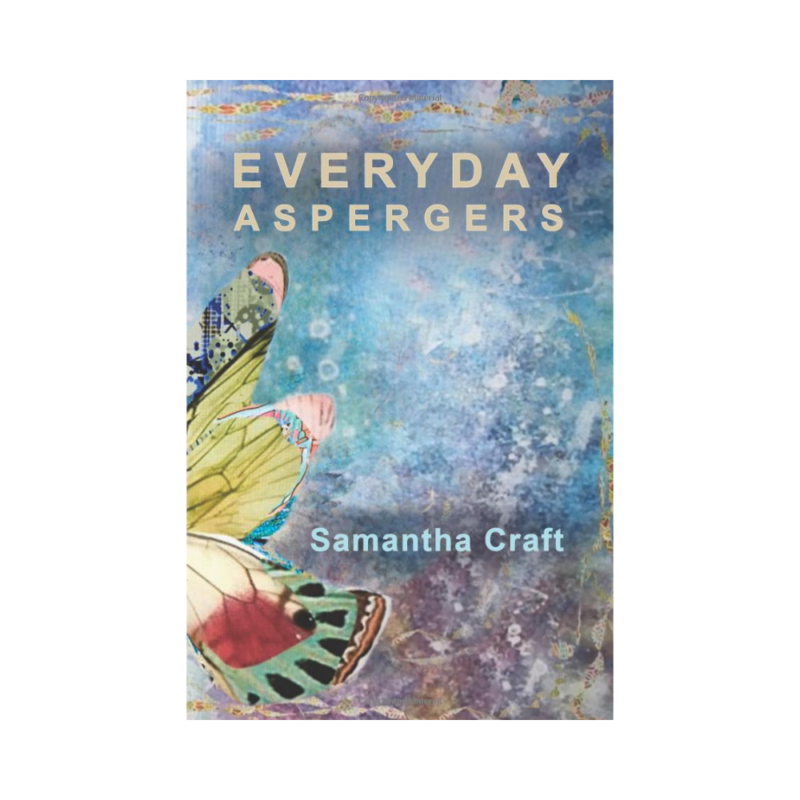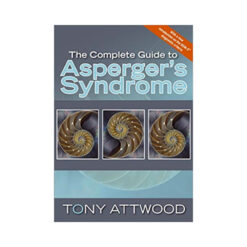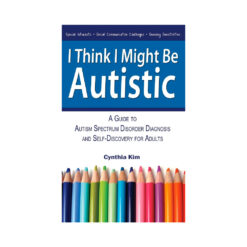First, Some Context.
With the history of autism being what it is (read Steve Silberman’s Neurotribes to find out what you’re missing), it makes sense that today, the general view is expanding the formerly male-centric view to include women and girls, non-binary people, and gender non-conforming people.
Women began the shift by collecting traits found to be common among them yet not represented in the standard criteria. The evolution continues as more people become aware of their neurology and find themselves represented in the standard traits and/or the broader set of traits, regardless of their gender.
In other words, Samantha Craft’s excellent list of autistic traits reported by women and girls very much applies to every sex and all genders. Think of it as a crowd-sourced expansion on the DSM.
Now, The Infamous List
With enthusiasm for the better-understood, more deeply authentic life that awaits the thousands of people who are unaware of their neurological makeup, the following is a re-posting of “Samantha Craft’s Autistic Traits Checklist“ (updated in 2020) by the best-selling author of “Everyday Aspergers”, Samantha Craft (a.k.a. Marcelle Ciampi).
This is a non-official, non-scientific list of traits. Here is Craft’s important disclaimer:
Disclaimer: This is one person’s opinion. It is not meant to replace the DSM-V Autism Spectrum condition definition, nor is this list meant to serve as an official diagnostic tool. 1000s and 1000s of individuals around the globe have used this list, in conjunction with the DSM-IV or DSM-V and a professional mental health professional’s guidance. It has been an important tool for females, particularly, but individuals across the gender spectrum identify with the list. The list has been translated into different languages and used around the globe. It is based on 8 years of communicating, almost daily, with those that are diagnosed or self-diagnosed autistic. It is not all inclusive. Some will fit into categories and not be autistic. This is meant as a springboard for discussion and more awareness.
* Highly intelligent does not relate to IQ levels. Autistic individuals are often dyslexic and have dysgraphia/other learning disabilities, but regardless can still be highly intelligent about particular subject matters, and have out-of-the-box thinking and verbal fluency capacities (fluid intelligence).
— Samantha Craft, “Samantha Craft’s Autistic Traits Checklist“. 2020.
The following, in its entirety, is by Samantha Craft.
Section A: Deep Thinkers
- A deep thinker
- A prolific writer drawn to poetry
- Highly intelligent*
- Sees things at multiple levels, including her own thinking processes
- Analyzes existence, the meaning of life, and everything, continually
- Serious and matter-of-fact in nature
- Doesn’t take things for granted
- Doesn’t simplify
- Everything is complex
- Often gets lost in own thoughts and “checks out” (blank stare)
Section B: Innocent
- Naïve
- Honest
- Experiences trouble with lying
- Finds it difficult to understand manipulation and disloyalty
- Finds it difficult to understand vindictive behavior and retaliation
- Easily fooled and conned
- Feelings of confusion and being overwhelmed
- Feelings of being misplaced and/or from another planet
- Feelings of isolation
- Abused or taken advantage of as a child but didn’t think to tell anyone
Section C: Escape and Friendship
- Survives overwhelming emotions and senses by escaping in thought or action
- Escapes regularly through fixations, obsessions, and over-interest in subjects
- Escapes routinely through imagination, fantasy, and daydreaming
- Escapes through mental processing
- Escapes through the rhythm of words
- Philosophizes, continually
- Had imaginary friends in youth
- Imitates people on television or in movies
- Treated friends as “pawns” in youth, e.g., friends were “students” “consumers” “members”
- Makes friends with older or younger females more so than friends her age (often in young adulthood)
- Imitates friends or peers in style, dress, attitude, interests, and manner (sometimes speech)
- Obsessively collects and organizes objects
- Mastered imitation
- Escapes by playing the same music over and over
- Escapes through a relationship (imagined or real)
- Numbers bring ease (could be numbers associated with patterns, calculations, lists, time and/or personification)
- Escapes through counting, categorizing, organizing, rearranging
- Escapes into other rooms at parties
- Cannot relax or rest without many thoughts
- Everything has a purpose
Section D: Comorbid Attributes
- OCD (Obsessive Compulsive Disorder)
- Sensory Issues (sight, sound, texture, smells, taste) (might have synesthesia)
- Generalized Anxiety
- Sense of pending danger or doom
- Feelings of polar extremes (depressed/over-joyed; inconsiderate/over-sensitive)
- Poor muscle tone, double-jointed, and/or lack in coordination (may have Ehlers Danlos Syndrome and/or Hypotonia and/or POTS syndrome)
- Eating disorders, food obsessions, and/or worry about what is eaten
- Irritable bowel and/or intestinal issues
- Chronic fatigue and/or immune challenges
- Misdiagnosed or diagnosed with a mental illness
- Experiences multiple physical symptoms, perhaps labeled “hypochondriac”
- Questions place in the world
- Often drops small objects
- Wonders who she is and what is expected of her
- Searches for right and wrong
- Since puberty has had bouts of depression (may have PMDD)
- Flicks/rubs fingernails, picks scalp/skin, flaps hands, rubs handstogether, tucks hands under or between legs, keeps closed fists, pacesin circles, and/or clears throat often
Section E: Social Interaction
- Friends have ended friendship suddenly (without female with AS understanding why) and/or difficult time making friends
- Tendency to overshare
- Spills intimate details to strangers
- Raised hand too much in class or didn’t participate in class
- Little impulse control with speaking when younger
- Monopolizes conversation at times
- Brings subject back to self
- Comes across at times as narcissistic and controlling (is not narcissistic)
- Shares in order to reach out
- Often sounds eager and over-zealous or apathetic and disinterested
- Holds a lot of thoughts, ideas, and feelings inside
- Feels as if she is attempting to communicate “correctly”
- Obsesses about the potentiality of a relationship with someone, particularly a love interest or feasible new friendship
- Confused by the rules of accurate eye contact, tone of voice, proximity of body, body stance, and posture in conversation
- Conversation are often exhausting
- Questions the actions and behaviors of self and others, continually
- Feels as if missing a conversation “gene” or thought-filter
- Trained self in social interactions through readings and studying of other people
- Visualizes and practices how she will act around others
- Practices/rehearses in mind what she will say to another before entering the room
- Difficulty filtering out background noise when talking to others
- Has a continuous dialogue in mind that tells her what to say and how to act when in a social situation
- Sense of humor sometimes seems quirky, odd, inappropriate, or different from others
- As a child it was hard to know when it was her turn to talk
- Finds norms of conversation confusing
- Finds unwritten and unspoken rules difficult to grasp, remember, and apply
Section F: Finds Refuge when Alone
- Feels extreme relief when she doesn’t have to go anywhere, talk to anyone, answer calls, or leave the house but at the same time will often harbor guilt for “hibernating” and not doing “what everyone else is doing”
- One visitor at the home may be perceived as a threat (this can even be a familiar family member)
- Knowing logically a house visitor is not a threat, doesn’t relieve the anxiety
- Feelings of dread about upcoming events and appointments on the calendar
- Knowing she has to leave the house causes anxiety from the moment she wakes up
- All the steps involved in leaving the house are overwhelming and exhausting to think about
- She prepares herself mentally for outings, excursions, meetings, and appointments, often days before a scheduled event
- OCD tendencies when it comes to concepts of time, being on time,tracking time, recording time, and managing time (could be carried over to money, as well)
- Questions next steps and movements, continually
- Sometimes feels as if she is on stage being watched and/or a sense of always having to act out the “right” steps, even when she is home alone
- Telling self the “right” words and/or positive self-talk (CBT) doesn’t typically alleviate anxiety. CBT may cause increased feelings of inadequacy.
- Knowing she is staying home all day brings great peace of mind
- Requires a large amount of down time or alone time
- Feels guilty after spending a lot of time on a special interest
- Uncomfortable in public locker rooms, bathrooms, and/or dressing rooms
- Dislikes being in a crowded mall, crowded gym, and/or crowded theater
Section G: Sensitive
- Sensitive to sounds, textures, temperature, and/or smells when trying to sleep
- Adjusts bedclothes, bedding, and/or environment in an attempt to find comfort
- Dreams are anxiety-ridden, vivid, complex, and/or precognitive in nature
- Highly intuitive to others’ feelings
- Highly empathetic, sometimes to the point of confusion
- Takes criticism to heart
- Longs to be seen, heard, and understood
- Questions if she is a “normal” person
- Highly susceptible to outsiders’ viewpoints and opinions
- At times adapts her view of life or actions based on others’ opinions or words
- Recognizes own limitations in many areas daily, if not hourly
- Becomes hurt when others question or doubt her work
- Views many things as an extension of self
- Fears others opinions, criticism, and judgment
- Dislikes words and events that hurt animals and people
- Collects or rescues animals (often in childhood)
- Huge compassion for suffering (sometimes for inanimate objects/personification)
- Sensitive to substances (environmental toxins, foods, alcohol, medication, hormones, etc.)
- Tries to help, offers unsolicited advice, or formalizes plans of action
- Questions life purpose and how to be a “better” person
- Seeks to understand abilities, skills, and/or gifts
Section H: Sense of Self
- Feels trapped between wanting to be herself and wanting to fit in
- Imitates others without realizing it
- Suppresses true wishes (often in young adulthood)
- Exhibits codependent behaviors (often in young adulthood)
- Adapts self in order to avoid ridicule
- Rejects social norms and/or questions social norms
- Feelings of extreme isolation
- Feeling good about self takes a lot of effort and work
- Switches preferences based on environment and other people
- Switches behavior based on environment and other people
- Didn’t care about her hygiene, clothes, and appearance before teenage years and/or before someone else pointed these out to her
- “Freaks out” but doesn’t know why until later
- Young sounding voice
- Trouble recognizing what she looks like and/or has occurrences ofslight prosopagnosia (difficulty recognizing or remembering faces)
- Feels significantly younger on the inside than on the outside (perpetually twelve)
Section I: Confusion
- Had a hard time learning that others are not always honest
- Feelings seem confusing, illogical, and unpredictable (self’s and others’)
- Confuses appointment times, numbers, and/or dates
- Expects that by acting a certain way certain results can be achieved, but realizes in dealing with emotions, those results don’t always manifest
- Spoke frankly and literally in youth
- Jokes go over the head
- Confused when others ostracize, shun, belittle, trick, and betray
- Trouble identifying feelings unless they are extreme
- Trouble with emotions of hate and dislike
- Feels sorry for someone who has persecuted or hurt her
- Personal feelings of anger, outrage, deep love, fear, giddiness, and anticipation seem to be easier to identify than emotions of joy, satisfaction, calmness, and serenity
- Difficulty recognizing how extreme emotions (outrage, deep love) will affect her and challenges transferring what has been learned about emotions from one situation to the next
- Situations and conversations sometimes perceived as black or white
- The middle spectrum of outcomes, events, and emotions is sometimes overlooked or misunderstood (all or nothing mentality)
- A small fight might signal the end of a relationship or collapse of world
- A small compliment might boost her into a state of bliss
Section J: Words, Numbers, and Patterns
- Likes to know word origins and/or origin of historical facts/root cause and foundation
- Confused when there is more than one meaning (or spelling) to a word
- High interest in songs and song lyrics
- Notices patterns frequently
- Remembers things in visual pictures
- Remembers exact details about someone’s life
- Has a remarkable memory for certain details
- Writes or creates to relieve anxiety
- Has certain “feelings” or emotions towards words and/or numbers
- Words and/or numbers bring a sense of comfort and peace, akin to a friendship
(Optional) Executive Functioning & Motor Skills
This area isn’t always as evident as other areas.
- Simple tasks can cause extreme hardship
- Learning to drive a car or rounding the corner in a hallway can be troublesome
- New places offer their own set of challenges
- Anything that requires a reasonable amount of steps, dexterity, or know-how can rouse a sense of panic
- The thought of repairing, fixing, or locating something can cause anxiety
- Mundane tasks are avoided
- Cleaning self and home may seem insurmountable
- Many questions come to mind when setting about to do a task
- Might leave the house with mismatched socks, shirt buttoned incorrectly, and/or have dyslexia and/or dysgraphia
- A trip to the grocery store can be overwhelming
- Trouble copying dance steps, aerobic moves, or direction in a sports gym class
- Has a hard time finding certain objects in the house but remembers with exact clarity where other objects are; not being able to locate something or thinking about locating something can cause feelings of intense anxiety (object permanence challenges) (even with something as simple as opening an envelope)
This unofficial checklist can be copied for therapists, counselors, psychiatrists, psychologists, professors, teachers, and relatives, if Samantha Craft’s name and contact information remain on the print out. This list was created in 2012 and updated in May 2016.

Shop Samantha Craft’s best-selling book Everyday Aspergers and more titles by autistic authors in our book store.
Craft’s Author’s Note:
I am diagnosed autistic/gifted-intellect, and have dyslexia, dyspraxia, GAD, PTSD, hEDS, POTS, fibromyalgia, and other chronic pain conditions. I am not unusual in my presentation; many autistic adults have many coexisting conditions. This post was originally composed when Asperger’s Syndrome was a stand-alone diagnosis. At that time, not much was written or discussed about females on the autism spectrum. Samantha Craft (@aspergersgirls) compiled this page.
Please don’t get hung up on the word Aspergers (as used on this page). It was my diagnosis in 2012 and that’s how I chose my Twitter name and connected 1000s around the globe. Many outside USA still have that diagnosis label. The title ‘Aspergers’ is used with the book title, as that is what the book was about: An adult struggling to understand a late-age diagnosis of Aspergers. It is not possible to change it to Everyday Autism, etc. as that changes the whole point of the book. Nor can I feasibly go back and change labels throughout 1000 pages of writing on my past blogs. The name/label on this page, my blog, and my book does not indicate any type of ableism. Those who know me, know me. I hope one word won’t discourage you from connecting.

Connect with Samantha Craft @aspergersgirls and at myspectrumsuite.com.
Want to learn more about yourself and your community? Start here.
ASD Guides & Autobiographies
Notes:
* Highly intelligent does not relate to IQ levels. Often Aspies are dyslexic and have dysgraphia and other learning disabilities but can be highly intelligent about particular subject matters, out-of-the-box thinking, and verbal fluency capacities.





